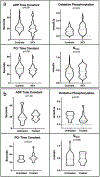In-vivo skeletal muscle mitochondrial function in Klinefelter syndrome
- PMID: 34493629
- PMCID: PMC8712372
- DOI: 10.1136/jim-2021-001966
In-vivo skeletal muscle mitochondrial function in Klinefelter syndrome
Abstract
Klinefelter syndrome (XXY) occurs in 1 in 600 males, resulting in testosterone deficiency and a high prevalence of insulin resistance. Testosterone deficiency in men is a known cause of insulin resistance, and mitochondrial dysfunction is hypothesized to mediate this relationship. The aim of this cross-sectional study was to evaluate muscle mitochondrial function in XXY compared with male controls. Twenty-seven boys with XXY (age 14.7±1.8 years) were compared with 87 controls (age 16.9±0.9). In-vivo calf muscle mitochondrial function was assessed via phosphorus magnetic resonance spectroscopy (31P-MRS) following 90 s of isometric 70% maximal exercise. Multiple linear regression was used to compare 31P-MRS outcomes (ADP and phosphocreatine (PCr) time constants, rate of oxidative phosphorylation (Oxphos), and Qmax or the maximal mitochondrial function relative to mitochondrial density) between groups after adjusting for age differences. There were no statistically significant differences in the mitochondrial outcomes of ADP, Oxphos, PCr, and Qmax between the groups. There were also no differences in a sensitivity analysis within the XXY group by testosterone treatment status. In this study, in-vivo postexercise skeletal muscle mitochondrial function does not appear to be impaired in adolescents with XXY compared with controls and is not significantly different by testosterone treatment status in XXY.
Keywords: muscle; skeletal; testosterone.
© American Federation for Medical Research 2022. No commercial re-use. See rights and permissions. Published by BMJ.
Conflict of interest statement
Competing interests: None declared.
Figures

Similar articles
-
Phosphorus 31 nuclear magnetic resonance spectroscopy suggests a mitochondrial defect in claudicating skeletal muscle.J Vasc Surg. 2000 May;31(5):944-52. doi: 10.1067/mva.2000.106421. J Vasc Surg. 2000. PMID: 10805885 Clinical Trial.
-
Comparison of in vivo postexercise phosphocreatine recovery and resting ATP synthesis flux for the assessment of skeletal muscle mitochondrial function.Am J Physiol Cell Physiol. 2010 Nov;299(5):C1136-43. doi: 10.1152/ajpcell.00200.2010. Epub 2010 Jul 28. Am J Physiol Cell Physiol. 2010. PMID: 20668212
-
Reduced skeletal muscle phosphocreatine concentration in type 2 diabetic patients: a quantitative image-based phosphorus-31 MR spectroscopy study.Am J Physiol Endocrinol Metab. 2018 Aug 1;315(2):E229-E239. doi: 10.1152/ajpendo.00426.2017. Epub 2018 Mar 6. Am J Physiol Endocrinol Metab. 2018. PMID: 29509433 Free PMC article.
-
Absolute quantification of phosphorus metabolite concentrations in human muscle in vivo by 31P MRS: a quantitative review.NMR Biomed. 2007 Oct;20(6):555-65. doi: 10.1002/nbm.1192. NMR Biomed. 2007. PMID: 17628042 Review.
-
MITOCHONDRIA: investigation of in vivo muscle mitochondrial function by 31P magnetic resonance spectroscopy.Int J Biochem Cell Biol. 2014 May;50:67-72. doi: 10.1016/j.biocel.2014.02.014. Epub 2014 Feb 22. Int J Biochem Cell Biol. 2014. PMID: 24569118 Review.
Cited by
-
Adaptive Triboelectric Nanogenerators for Long-Term Self-Treatment: A Review.Biosensors (Basel). 2022 Dec 5;12(12):1127. doi: 10.3390/bios12121127. Biosensors (Basel). 2022. PMID: 36551094 Free PMC article. Review.
References
-
- Granato S, Barbaro G, Di Giorgio MR, et al. Epicardial fat: the role of testosterone and lipid metabolism in a cohort of patients with Klinefelter syndrome. Metabolism 2019;95:21–6. - PubMed
-
- Accardo G, Amoresano Paglionico V, Di Fraia R, et al. Management of cardiovascular complications in Klinefelter syndrome patients. Expert Rev Endocrinol Metab 2019;14:145–52. - PubMed
-
- Lizarazo AH, McLoughlin M, Vogiatzi MG. Endocrine aspects of Klinefelter syndrome. Curr Opin Endocrinol Diabetes Obes 2019;26:60–5. - PubMed
Publication types
MeSH terms
Substances
Grants and funding
LinkOut - more resources
Full Text Sources
Medical

